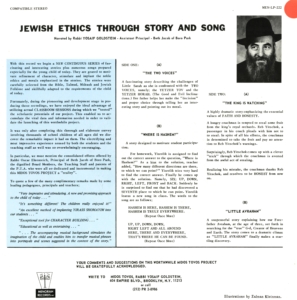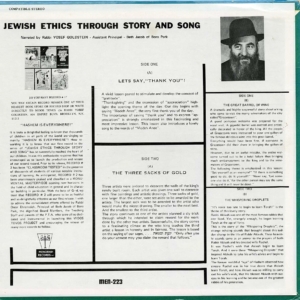I have here transcribed Rabbi Yosef Goldstein’s introduction to the story, “Where is Hashem?” framing the song “Hashem is Everywhere!”[2] This seems to be the informal, popular title for the song, as given on the liner notes of the second album in the series (מדות טובות Jewish Ethics Through Story and Song vol. 1, no. 2, Menorah Records 1972). There is no title given for the song on the cover and liner notes of the album on which it originally appears. Only the name of the framing story is provided there. as well as his instructions for reciting the song, which begins as follows:
A wise man was once asked, “Can you tell me, where is God?” To this he answered, “Can you tell me where he is not?”[3] This is almost certainly a story built around Yehudah haLevi’s 12th century piyyut Ana Emtsaeka. A short prayer on this theme is quoted in Ḥovot haLevavot (Duties of the Heart, First Treatise on Unity 10:69) by Baḥya ibn Paquda (1050-1120): ונאמר על קצת מן החכמים שהיה אומר בתפלתו אלהי אנה אמצאך אך אנה לא אמצאך נסתרת ולא תראה והכל ממך מלא. דומה למה שאמר יתברך אֶת־הַשָּׁמַיִם וְאֶת־הָאָרֶץ אֲנִי מָלֵא נְאֻם־יְהוָה (ירמיהו כג:כד) (It is said of one of the Sages who would say in his prayer: “My elo’ah, where can I find you, yet where can I not find you. You are hidden and invisible yet everything is filled with you, similar to the verse “‘Do I not fill heaven and earth,’ says YHVH (Jeremiah 23:24)”). Find also Proverbs 7:15 and Song of Songs 8:1.
God is everywhere. Yes, dear children, God is everywhere. True, we cannot see him. He is invisible, but he is everywhere. He fills the world and surrounds it too.
Oh what a lovely feeling to know that God is at all times and in all places together with us. He is looking over us with an ever watchful eye. He protects us and blesses us with all good.
| Translation (Yiddish) | Source (English) |
|---|---|
|
|
Don’t forget to point to the corners as you sing the song.
As you say “Up up,” you point upwards. As you say “Down down,” you point downwards and so on. And remember, when you say “Here, there, and everywhere,” you first point to yourself, and then make a big circle and point everywhere.[4] In the story Rabbi Goldstein uses to frame the song, the child singing the song and pointing shares the following insight with his mother, “I just learnt in the Torah that Hashem blew a soul, a neshamah, into Adam, the first man, and that made him alive. So that means that we have a neshamah, a soul which is a part of God. God blew it into us and it keeps us alive. So, the seventh place to point to is to myself. I have a part of God right in me.” Find Genesis 2:7, and the development of the Jewish belief in a pintele yid. On the history of this idea, the scholar Rabbi Louis Jacobs (1920-2006) writes: “The belief that there is a special mystical ‘spark’ in every human breast can be traced back, in western mysticism, at least to Jerome in the fourth century. Both Bonaventura and Bernard of Clairvaux speak of this mystical organ; the latter, calling it scintillula, a small spark of the soul, and speaking of the nearness of God, said: ‘Angels and archangels are within us, but He is more truly our own who is not only with us but in us.’ However, both these mystics are anxious to prevent an identification of this mystical spark with the divine. Eckhart, on the other hand, embraces the identification, calling the spark, among other endearing names, das Kleidhaus Gottes, ‘the house in which God attires Himself ’. This and other pantheistic tendencies in Eckhart’s thought were condemned in the papal Bull of 1529…” (in “The Doctrine of the ‘Divine Spark’ in Man in Jewish Sources” Studies in Rationalism, Judaism and Universalism, ed. Raphael Loewe (Humanities: 1966) 87-114.) For those more familiar with Quaker theology than Ḥassidut, they might recall a similar belief shared by George Fox (1624-1691). Elsewhere, one can find the idea of the pintele yid associated (or conflated) with the idea of the tselem Elohim of Genesis 1:26-27 rather than the animating breath of Genesis 2:7. |
|
ה׳ איז דא
ה׳ איז דארט ה׳ איז באמת אומעטום |
Hashem is here
Hashem is there Hashem is truly everywhere (×2) |
|
אױבּן אױבּן
אונטן אונטן רעכט לינקס און אין אַלע ערטער דאָ, דאָרט און אומעטום ס׳איז װוּ מ׳קען ה׳ געפינען. |
Up up
Down down Right left And all around Here, there, and everywhere That’s where he can be found. (×2) |
The pedagogical song “Hashem is Everywhere!” by Rabbi Yosef Goldstein (1928-2013) can be found in the context of his story, “Where is Hashem?,” the second track on his album מדות טובות Jewish Ethics Through Story and Song (Menorah Records 1972). To the best of my limited abilities, I have added a Yiddish translation. Please offer corrections, improvements, or additional translations. (Leave a comment or contact us.) Many thanks to Baruch Thaler for his improvements!
We have not yet been able to determine whether the song was originally published along with the album, or whether the notes to the album were, themselves, registered with the Copyright Office. No copyright notice appears on the album cover, a requirement for materials receiving copyright at the time of its publication. Since the copyright status of this work is ambiguous at best, we are invoking the rarely used Fair Use declaration under which this sort of content may still be shared, dina malkhuta dina, in the United States, for non-commercial, scholarly, and educational purposes only. However, we should stress, this work may indeed already be in the Public Domain due to the lack of a copyright notice on the album cover on which the work was published.
One last point. While we don’t know (yet) how long this song existed before it was recorded, I believe that the phrase “here, there, and everywhere” helps to date it to after the Beatles’s album Revolver (1966), as the fifth track, “Here, There, and Everywhere,” by Paul McCartney became very well established. It would be lovely to learn whether the line “Here, there, and everywhere” in “Hashem is Everywhere!” was inspired by (or composed in response to) any work by the Beatles. For a song whose explicit theme is directly related, find George Harrison’s “Within You Without You” from Sgt. Pepper (1967). –Aharon Varady
Recordings
Source(s)
Notes
| 1 | Find “An Ancient Meditation,” in The History and Varieties of Jewish Meditation (Mark Verman 1996), pages 151-160. |
|---|---|
| 2 | This seems to be the informal, popular title for the song, as given on the liner notes of the second album in the series (מדות טובות Jewish Ethics Through Story and Song vol. 1, no. 2, Menorah Records 1972). There is no title given for the song on the cover and liner notes of the album on which it originally appears. Only the name of the framing story is provided there. |
| 3 | This is almost certainly a story built around Yehudah haLevi’s 12th century piyyut Ana Emtsaeka. A short prayer on this theme is quoted in Ḥovot haLevavot (Duties of the Heart, First Treatise on Unity 10:69) by Baḥya ibn Paquda (1050-1120): ונאמר על קצת מן החכמים שהיה אומר בתפלתו אלהי אנה אמצאך אך אנה לא אמצאך נסתרת ולא תראה והכל ממך מלא. דומה למה שאמר יתברך אֶת־הַשָּׁמַיִם וְאֶת־הָאָרֶץ אֲנִי מָלֵא נְאֻם־יְהוָה (ירמיהו כג:כד) (It is said of one of the Sages who would say in his prayer: “My elo’ah, where can I find you, yet where can I not find you. You are hidden and invisible yet everything is filled with you, similar to the verse “‘Do I not fill heaven and earth,’ says YHVH (Jeremiah 23:24)”). Find also Proverbs 7:15 and Song of Songs 8:1. |
| 4 | In the story Rabbi Goldstein uses to frame the song, the child singing the song and pointing shares the following insight with his mother, “I just learnt in the Torah that Hashem blew a soul, a neshamah, into Adam, the first man, and that made him alive. So that means that we have a neshamah, a soul which is a part of God. God blew it into us and it keeps us alive. So, the seventh place to point to is to myself. I have a part of God right in me.” Find Genesis 2:7, and the development of the Jewish belief in a pintele yid. On the history of this idea, the scholar Rabbi Louis Jacobs (1920-2006) writes: “The belief that there is a special mystical ‘spark’ in every human breast can be traced back, in western mysticism, at least to Jerome in the fourth century. Both Bonaventura and Bernard of Clairvaux speak of this mystical organ; the latter, calling it scintillula, a small spark of the soul, and speaking of the nearness of God, said: ‘Angels and archangels are within us, but He is more truly our own who is not only with us but in us.’ However, both these mystics are anxious to prevent an identification of this mystical spark with the divine. Eckhart, on the other hand, embraces the identification, calling the spark, among other endearing names, das Kleidhaus Gottes, ‘the house in which God attires Himself ’. This and other pantheistic tendencies in Eckhart’s thought were condemned in the papal Bull of 1529…” (in “The Doctrine of the ‘Divine Spark’ in Man in Jewish Sources” Studies in Rationalism, Judaism and Universalism, ed. Raphael Loewe (Humanities: 1966) 87-114.) For those more familiar with Quaker theology than Ḥassidut, they might recall a similar belief shared by George Fox (1624-1691). Elsewhere, one can find the idea of the pintele yid associated (or conflated) with the idea of the tselem Elohim of Genesis 1:26-27 rather than the animating breath of Genesis 2:7. |




